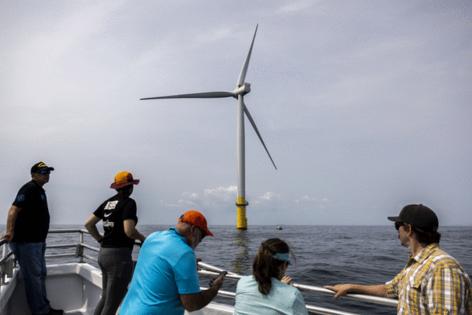Officials search for offshore wind radar interference fix
Published in Political News
WASHINGTON — Racing against the Biden administration’s clean energy agenda, members of Congress are pressing for a solution for wind turbines that interfere with plane radars before more offshore wind projects are approved.
As turbines continue to expand in size and number, they create clutter on radar systems that increase the false alarm detection rate. In response, these systems raise the threshold considered a detection and, as a result, may miss actual targets.
The turbines don’t just impact air traffic control and flight safety, but also radar associated with weather forecasting and warnings, coastal sea-surface and maritime surveillance, oceanographic measurements, and homeland and national defense missions, according to the Energy Department.
Appropriators in the report of the fiscal 2022 government funding bill required an update on the efforts of the Wind Turbine Radar Interference Mitigation working group — a coalition of federal agencies led by the Energy Department formed in 2016 to find a solution to radar interference.
More recently, House lawmakers included a provision in their Federal Aviation Administration reauthorization bill that would require the president to certify that offshore wind projects would not interfere with any aviation radar activities.
However, the working group has yet to find an efficient, cost-effective way to permanently restore impacted radar capabilities, according to the February Energy Department report in response to the 2022 congressional request.
According to federal officials familiar with the issue, current offshore wind developments pose “no significant threat” to airspace or radar missions, and the projects that do pose impacts can be mitigated with existing measures. But additional projects on the horizon add urgency for a permanent solution.
There are currently three completed offshore wind farms in operation in the U.S. — one off of Rhode Island’s Block Island, another off of the coast of Virginia, with a combined capacity of 42 megawatts, and one off Montauk Point in New York, with a capacity of 132 megawatts.
A fourth project, the 806-megawatt Vineyard Wind farm off of Massachusetts, was delivering power from the first five turbines as of February.
But a 2023 Energy Department report said more than 20 gigawatts of additional capacity in the permitting phase is moving toward final approval, bringing the U.S. closer to the Biden administration’s goal to deploy 30 GW of offshore wind energy by 2030.
The Biden administration approved the eighth offshore wind project in April, bringing the total amount of offshore wind energy the administration has approved to 10 GW.
Federal officials said that the FAA and Defense Department “rigorously assess” each proposed wind project for potential impact to air safety and DOD missions, and all current projects have been cleared by the agencies.
Since the working group began researching mitigation measures in 2016, however, members found more radar issues, officials said, causing them to push back their timeline for finding a permanent solution from 2025 to 2035.
In the February report to Congress, the working group identified over 10 mitigation tools currently being developed or tested, some of which have near-term deployment targets. But the group also cited a handful of mitigation measures they aren’t able to test and deploy due to resource constraints, which include some radar upgrades and replacements.
Federal officials added that the ultimate solution is likely to come in the form of new radars, but replacing existing ones is both costly and complex.
“We’re collecting data to try and model the problem as best as we foresee it, and I guess we won’t know how bad that problem is going to be until all these turbines eventually get built,” said Hugh Roarty, an oceanographer at Rutgers University, which employs radars for measuring ocean currents that are impacted by offshore wind turbines. “We’ve been working with the five turbines that are off of Block Island right now, but once all those (other projects) start spinning, then we’re going to see if our mitigation efforts are working.”
The provision aimed at pressuring the administration to find a radar interference fix, however, is not included in the Senate version of the FAA reauthorization bill. House and Senate lawmakers are negotiating an agreement on the bill, which is facing a May 10 deadline, although it’s not clear if this provision will be included in the final version.
©2024 CQ-Roll Call, Inc., All Rights Reserved. Visit cqrollcall.com. Distributed by Tribune Content Agency, LLC.







Comments